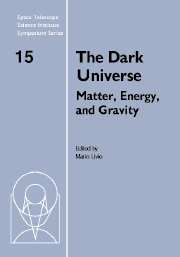Book contents
- Frontmatter
- Contents
- Participants
- Preface
- A brief history of dark matter
- Microlensing towards the Magellanic Clouds: Nature of the lenses and implications on dark matter
- Searching for the Galactic dark matter
- Hot gas in clusters of galaxies and ΩM
- Tracking the baryon density from the Big Bang to the present
- Modified Newtonian Dynamics and its implications
- Cosmological parameters and quintessence from radio galaxies
- The mass density of the Universe
- Growth of structure in the Universe
- Cosmological implications of the most distant supernova (known)
- Dynamical probes of the Halo Mass Function
- Detection of gravitational waves from inflation
- Cosmological constant problems and their solutions
- Dark matter and dark energy: A physicist's perspective
Cosmological parameters and quintessence from radio galaxies
Published online by Cambridge University Press: 21 August 2009
- Frontmatter
- Contents
- Participants
- Preface
- A brief history of dark matter
- Microlensing towards the Magellanic Clouds: Nature of the lenses and implications on dark matter
- Searching for the Galactic dark matter
- Hot gas in clusters of galaxies and ΩM
- Tracking the baryon density from the Big Bang to the present
- Modified Newtonian Dynamics and its implications
- Cosmological parameters and quintessence from radio galaxies
- The mass density of the Universe
- Growth of structure in the Universe
- Cosmological implications of the most distant supernova (known)
- Dynamical probes of the Halo Mass Function
- Detection of gravitational waves from inflation
- Cosmological constant problems and their solutions
- Dark matter and dark energy: A physicist's perspective
Summary
FRIIb radio galaxies provide a tool to determine the coordinate distance to sources at redshifts from zero to two. The coordinate distance depends on the present values of global cosmological parameters, quintessence, and the equation of state of quintessence. The coordinate distance provides one of the cleanest determinations of global cosmological parameters because it does not depend on the clustering properties of any of the mass-energy components present in the universe.
Two complementary methods that provide direct determinations of the coordinate distance to sources with redshifts out to one or two are the modified standard yardstick method utilizing FRIIb radio galaxies, and the modified standard candle method utilizing type Ia supernovae. These two methods are compared here, and are found to be complementary in many ways. The two methods do differ in some regards; perhaps the most significant difference is that the radio galaxy method is completely independent of the local distance scale and independent of the properties of local sources, while the supernovae method is very closely tied to the local distance scale and the properties of local sources.
FRIIb radio galaxies provide one of the very few reliable probes of the coordinate distance to sources with redshifts out to two. This method indicates that the current value of the density parameter in non-relativistic matter, Ωm, must be low, irrespective of whether the universe is spatially flat, and of whether a significant cosmological constant or quintessence pervades the universe at the present epoch.
- Type
- Chapter
- Information
- The Dark UniverseMatter, Energy and Gravity, pp. 77 - 95Publisher: Cambridge University PressPrint publication year: 2004



